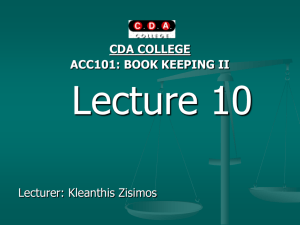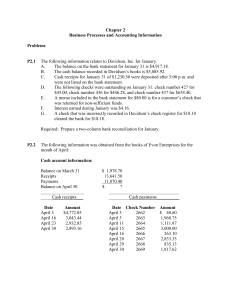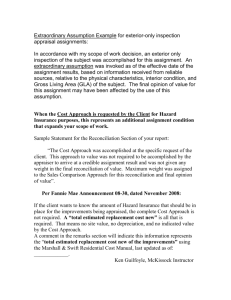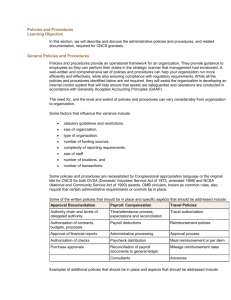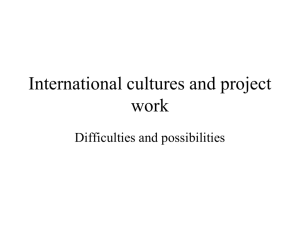Eros DeSouza
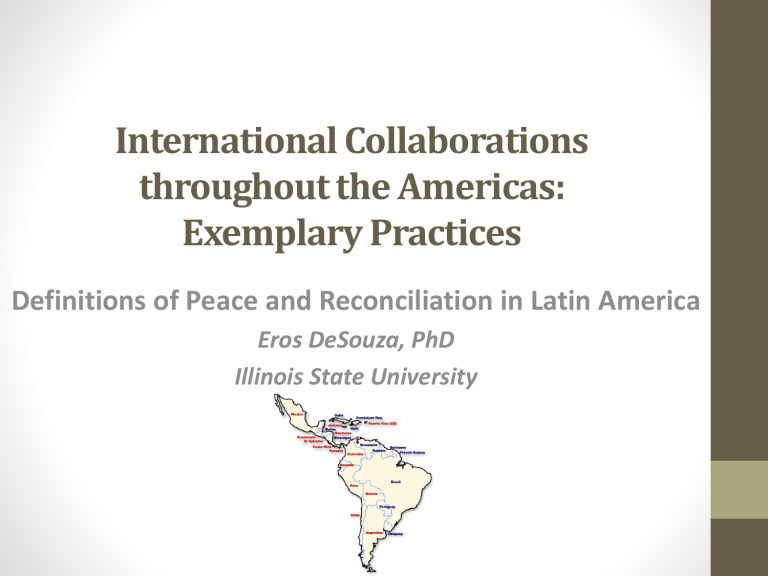
International Collaborations throughout the Americas:
Exemplary Practices
Definitions of Peace and Reconciliation in Latin America
Eros DeSouza, PhD
Illinois State University
Key ideas on Conducting Research in Latin America (and Elsewhere)
• Action research: It challenges the status quo and promotes social change
• It can be dangerous for indigenous researchers in former totalitarian regimes to conduct studies in
“sensitive topics” such as state terrorism
• Thus, alliances between researchers from developed countries and developing countries may be beneficial to both parties
• Qualitative research allows research participants to have a voice and better captures the complexities of their lives than quantitative research
Purpose of the Study
• Latin American adults defined in their own words what peace and reconciliation meant to them
• Galtung (1964, 1969) defined negative peace as the lack of war and absence of direct physical harm (violence), whereas positive peace refers to the absence of structural oppression
• Galtung (2001) also defined reconciliation as end of hostility accompanied by healing the relationship between two parties (i.e., oppressed and oppressor)
• According to Bloomfield (2003, 2006), reconciliation is both a goal
(i.e., future-oriented, something to strive for, as an end-state of harmony) and a process (i.e., based on the present, as a means of living together in peace)
• We examined gender differences of men’s and women’s spontaneous definitions of peace and reconciliation and whether or not they are achievable; we also examined whether men’s and women’s definitions resembled Galtung’s and Bloomfield’s
Method
• Grounded theory (Strauss & Corbin, 1998) was used during the coding process of the definitions of peace and reconciliation from ordinary people in civil society from Argentina, Brazil,
Colombia, Costa Rica, Nicaragua, Peru, and Puerto Rico (see
Malley-Morrison & Mercurio, 2013, for further details regarding the coding taxonomy, including unitizing)
• The Latin American sample consisted of 713 adults (mean age =
28.5, ranging from 18 to 79 years; 61% women). Of these, 18% reported having been involved in protest activities
Results
• The findings revealed a stark contrast between men’s and women’s definitions of peace and reconciliation
• A significantly greater proportion of women (78%) than men
(25%) defined peace using one or more of the positive peace categories, especially calm/tranquility (21% and 17%, respectively)
• On the other hand, a significantly greater proportion of men
(25%) than women (18%) defined peace using one or more of the negative peace categories, especially rejecting violence
(10% and 6%, respectively)
• Thus, these data suggest that in our Latin American sample women emphasize more positive peace than men, whereas men emphasize more negative peace than women
Results
• Concerning involvement in protest activities, a significantly greater proportion of participants who reported having engaged in protest (26%) gave responses that were coded into one or more of the categories that are grouped under questioning the achievability/ideal presence than those who never engaged in protest (15%). There was also a trend for those who engaged in protest activities to be less
(18%) likely than those who did not (22%) to even define peace as the absence of violence (i.e., negative peace presence). Thus, these data suggest that those who reported having engaged in protest activities might be disillusioned with the prospects of peace, even negative peace, and openly question its achievability
Results
• Again, a striking gender gap emerged, with a significantly greater proportion of women (86%) than men (77%) defining reconciliation as a process, especially in terms of coming into an agreement, compromise, and negotiation (18% and 13%, respectively)
• Women were also significantly less likely (13%) than men (18%) to define reconciliation as peace (state), and a greater proportion of men (17%) than women (12%) questioned the achievability of reconciliation
• Thus, these findings suggest that women are more likely than men to view reconciliation as a process rather than as a goal, and to favor relationship-building in the form of agreement, compromise, or negotiation
Conclusions
• These findings seem to indicate the optimism and resilience of Latin
American women who suffered many losses during the state terror and insurgency that afflicted many Latin American countries during the second half of the 20 th century (DeSouza & Stevens, 2009)
• Overall, this optimism may also reflect widespread political liberalization, return to democracy, and also successful peace negotiations in Latin America (van der Borgh, 2001)
• However, current high crime rates and wealth inequality in Latin
America may, in part, explain the disillusionment with the attainability of peace found among some participants who reported having engaged in protest activities
• Future studies should investigate other differences in the definitions of peace and reconciliation based on social class, region (e.g., urban versus rural), and political affiliation to name just a few.
• These findings should generate discussions in the classroom in courses related to the psychology of peace, social change, psychology of gender, and international psychology. It is important to expand psychology beyond the individual level to encompass global issues
